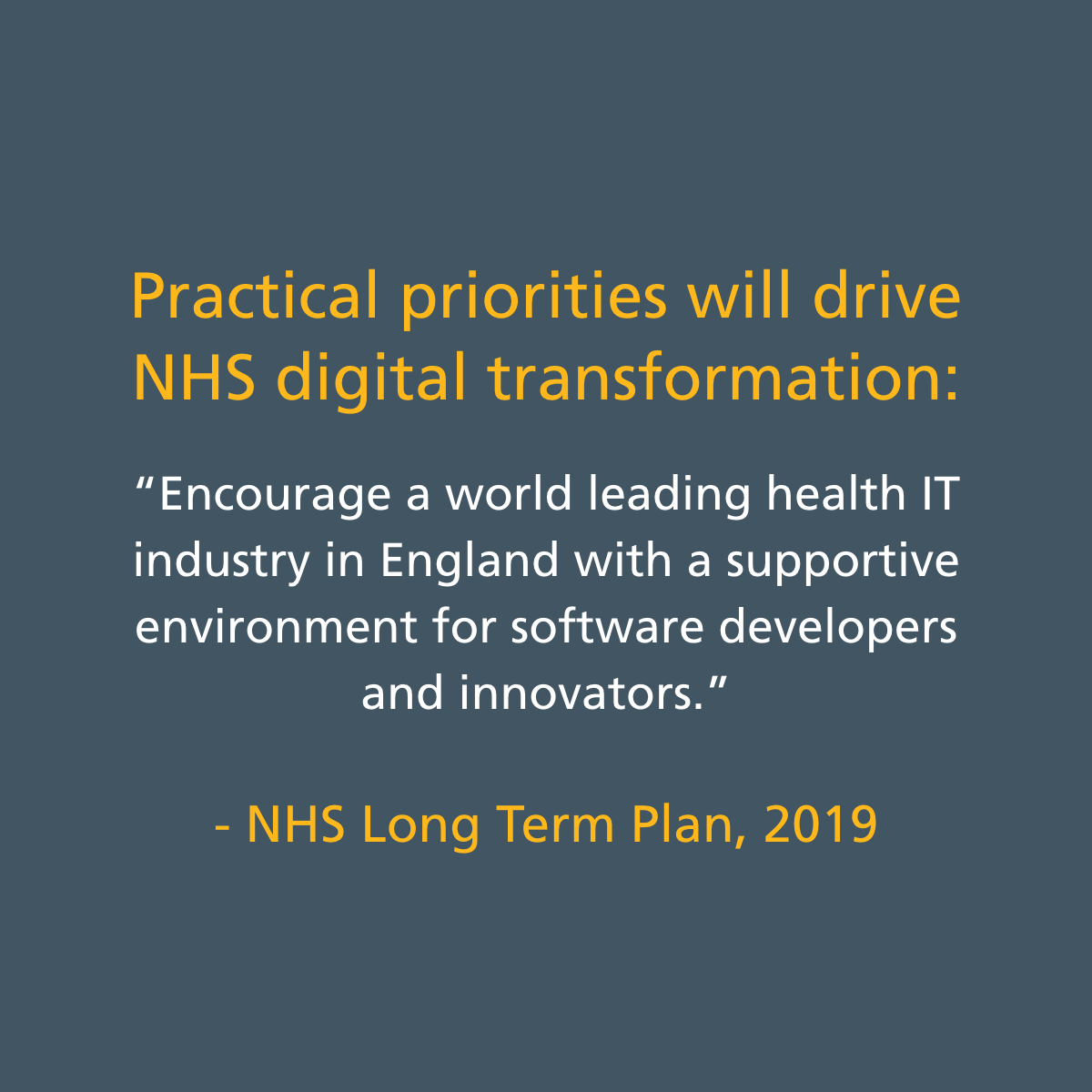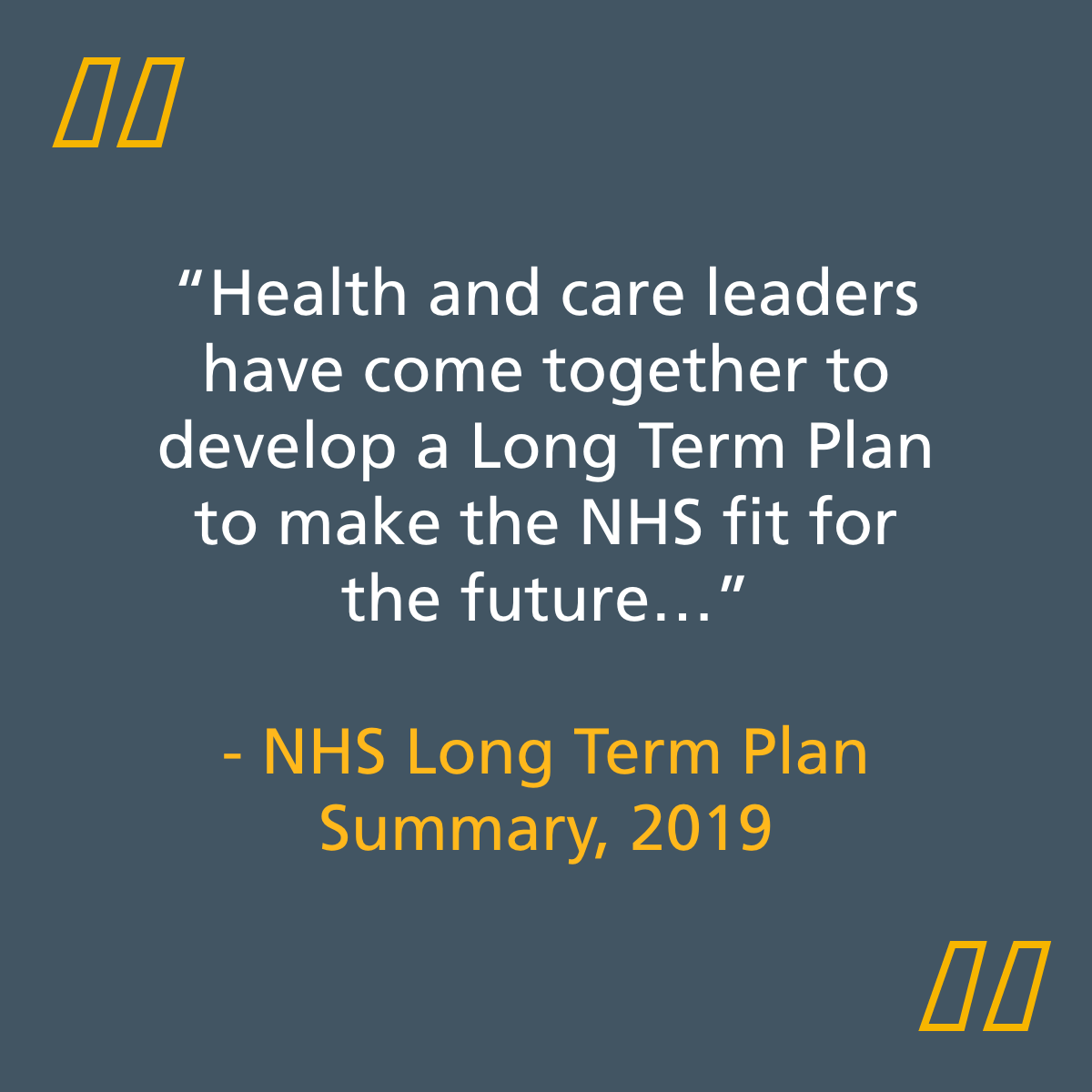Virtually every aspect of modern life has been, and is continuing to be, radically re-shaped by innovation and technology – and healthcare in the NHS is no exception.
In fact, the NHS is a hotbed of innovation and technological advancement that is revolutionising how our hospitals and clinicians work, and how patients are treated. Technology is continually opening up new possibilities for prevention, care and treatment.
The NHS Long Term Plan, also known as the NHS 10-Year Plan, is a document published by NHS England just over three years ago, which sets out its priorities for healthcare over the next 10 years as it looks towards its 80th anniversary.
But here lies a conundrum. While the NHS might be a hotbed of innovations and technological advancement, the long term plan also acknowledges the way care is delivered remains locked into the service model largely created when the NHS was founded in 1948.
Part of the vision is for technology to play a central role in realising the NHS Long Term Plan, helping clinicians use the full range of their skills, reducing bureaucracy, stimulating research and enabling service transformation. People will have more control over the care they receive and more support to manage their health, to keep themselves well and better manage their conditions.

Innovation and collaboration
The Health Informatics Service (THIS) enables new, empowering, efficient and secure communications and IT services for clients including health trusts, GPs, laboratories, hospices and care charities.
Solutions delivered by THIS for its host trust, the Calderdale and Huddersfield NHS Foundation Trust (CHFT), have contributed to its current status as a ‘digitally aspirant’ trust, taking it from 150th in a digital trust league table to being one of the most digitally mature trusts in England.
The NHS Long Term plan sets out practical priorities that will drive the digital transformation of the NHS. They include:
- Create straightforward digital access to NHS services, and help patients and their carers manage their health.
- Ensure that clinicians can access and interact with patient records and care plans wherever they are.
- Use predictive techniques to support local health systems to plan care for populations.
- Use intuitive tools to capture data as a by-product of care in ways that empower clinicians and reduce the administrative burden.
- Encourage a world leading healthcare IT industry in England with a supportive environment for software developers and innovators.
In the last few years alone, THIS’ host trust has spent in the region of £16m on digital health solutions to change the healthcare landscape in its hospitals and in the services it provides. THIS’ role is to work with its trust and its clients on building capability.
Luke Stockdale, THIS’ Director of Digital Transformation and Innovation, says:
“We just don’t land projects; we build capability that iteratively needs to be improved. Yes, it’s important we land them but then we start looking at the next cycle and build on them to make them better and better with maturity.
“A lot of the work we do comes about through our relationships with suppliers, and through sharing what we do on LinkedIn and Twitter. Sometimes a supplier will want to land a project so they have a reference site to show other potential customers.”
Digital transformation in action
- Ensure clinicians can access and interact with patient records and care plans wherever they are.
CHFT’s Medical Iinteroperability Gateway (MIG) makes vital GP, social care and community healthcare patient data available to hospital and other clinicians, increasing efficiency and improving care quality.
Designed to connect otherwise incompatible systems, the MIG plugs the gaps when patients admitted to hospital can’t provide medical and other historical details, providing patient data that ranges from demographics and diagnoses to social care plans, allergies, recent procedures, therapies and tests.
This enables Emergency Department (ED) and other acute clinicians can make informed treatment decisions faster, preventing unnecessary hospital admissions and duplicated tests.
- Use predictive techniques to support local health systems to plan care for populations.
THIS is using predictive analytics to gauge the survival chances of hospital patients, feeding into ‘real time’ standardised mortality ratios.
The pioneering work is being done at CHFT’s Huddersfield Royal Infirmary and Calderdale Royal Hospital in Halifax. It means the hospitals will have current mortality ratios instead of waiting for the national publication of the Hospital Standardised Mortality Ratio data (HSMR), which is delivered three months in arrears.
THIS’ Information Services (IS) team is collating data from the Trust’s Cerner Milliennium EPR and other far-reaching clinical systems to gather information that then populates predictive R analytics software, an open-source software used for all kinds of data science, statistics, and visualisation projects. R programming language is powerful, versatile, and able to be integrated into business information platforms, to help users get the most out of business-critical data.
The benefits of real time HSMR will enable to the trust to pinpoint trends and variations before the national figures are published, as well as improve its ability to improve its clinical review process.
Patients arriving at the hospitals are assessed on several criteria which create a HSMR metric – these include a patient’s age, gender, exposure to deprivation, how they were admitted, comorbidity, whether they have a paliative care code and the actual diagnosis.
Based on the information gathered, a patient is allocated an expected death calculation (EDC) ranging between 0 and 1. A score of 0 indicates certain death while a score of 1 indicates 100 per cent survival.
Taking into account all known factors, the scores are worked out incrementally, so for instance, someone might be given an EDC of 0.376 – which can be expressed as a percentage, ie they have a 37.6 per cent chance of dying.
The EDC figures create a ‘league table’ of patients - those at the ‘top’ with scores at the high end of the ratio scale and those at the ‘bottom’ being patients with the lower survival chances.
Oliver Hutchinson, who is part of THIS’ IS team and leads the mortality ratio analysis says:
“It will help us pinpoint potential clinical areas to improve. For example, if you’ve got a patient that had a low likelihood of death and they actually died, we can look into that case and hold a clinical review to see if there is anything we can learn to prevent a death in similar circumstances in the future.”
The system can also highlight errors in recording a patient’s medical history. For example, someone with a low EDC might have certain factors missing from their medical record, which would decrease their survival chances. With these issues signposted in advance, it allows for more accurate reporting.
Creating the real time HMSR is THIS’ latest predicitive analytics project. Other examples have focused on ICU admissions during the pandemic and, more recently, A&E admissions, to predict the percentage of patients arriving at A&E being admitted to hospital or sent home.
- Use intuitive tools to capture data as a by-product of care in ways that empower clinicians and reduce the administrative burden.
Voice recognition (VR) technology is being used at CHFT hospitals to reduce repetitive tasks surrounding the recording, checking and despatch of patients’ clinical notes and letters.
Working in partnership with Nuance Dragon Medical One, a cloud-based solution hosted on Microsoft Azur, THIS is pioneering VR in CHFT’s musculoskeletal and physiotherapy services with an ambition to extend its use further.
In one six-month period, staff inputted more than 40,000 minutes of speech text using the voice recognition technology. Because inputting speech with voice recognition is 3-5 times faster than typing, THIS estimates the new system has saved approximately 150,000 minutes (2,500 hours) that would previously been required to type up the information.
Using Nuance Dragon Medical One, each clinician reads through the relevant script displayed on-screen and uses their voice commands known as AutoTexts to add specific details, such as the individual patient’s name and medical details, at highlighted brackets tailored to the patient within the text.
Luke Stockdale:
“Traditionally, consultants spoke into dictating machines and secretaries typed up the patient notes which had to be checked before being filed or despatched as letters. The process could involve four handovers.
“Now with voice recognition, the clinician speaks and uses AutoTexts, the secretary checks the notes, and the notes are actioned. Clinicians can then focus more on patient care and secretaries can focus on other more valuable tasks relating to management of the practice or department. Voice recognition also removes variance and creates common quality with all notes.”

- Encourage a world leading health IT industry in England with a supportive environment for software developers and innovators.
THIS collaborated with two major suppliers to create a link between CHFT’s drug prescription system, hosted on EMIS software, and its Electronic Patient Record (EPR), hosted by Cerner Millennium. It is a first-of-type solution across the NHS, which has removed the need for duplicated tasks between two standalone systems.
Luke Stockdale:
“It meant people double keying because we were prescribing on EMIS and then having to transfer the information to the EPR.
“That interoperability is really key for us here. It's allowed us to speed up the procedural flow in the hospital by being able to prescribe and administer drugs quicker, and to get our discharges more efficient. It frees up pharmacy time too, which is critical for patients waiting to take their medicines home. Another benefit is that it reduces errors, because the information is going straight through to both systems.”
“You might think it’s not that hard to check a drug against a patient, but when you consider the amount of drugs that we administer to the sheer number we administer to, it’s massive. Essentially, closed loop aministration means we are giving the right drug, to the righ patient in the right volume.”
The link also supports the Trust’s closed loop drug administration policy, whereby drugs and patients are both barcoded and scanned to ensure they match before the medicine is administered, again with the aim of reducing errors.
- Create straightforward digital access to NHS services, and help patients and their carers manage their health.
Working with Zebra hand held computers, THIS has developed new uses for the devices that were originally used for scanning patient and medicine bar codes to ensure the right people were receiving the right treatments.
They're now being used for additional purposes such as video calls via Microsoft Teams for patients to connect with relatives – invaluable during the pandemic - and updating records in real time at the bedside.
End-user technology also means patients can be monitored at home – blood pressure monitors are a good example of this. Wearable technology is also coming into use that will continually monitor a patient’s observations and feed the data back to the hospital.

THIS’ role in healthcare organisations
While much of THIS’ work is centred on its host trust, it provides a host of services to other clients, including:
- Healthcare & NHS IT support
- Healthcare & NHS professional services
- Healthcare & NHS registration authority support
- Information governance for NHS & healthcare
Rob Birkett:
“We’ve developed from being a support function to absolutely underpinning clinical decision making and clinical delivery ingrained in patient care. And that's a big step forward.
“We work with about 50 clients, with a core of 10 taking the bulk of our services. We’re in a really unique position in terms of delivering across an array of services. For example, we know as much about GP systems as we do about a radiology department. There's not many other organisations in that position and as the NHS landscape shifts towards system-based outcomes and system-based working, that's already our mindset.”
Contact THIS
Great relationships represent a key ingredient to successful healthcare outcomes and collaborative work.
We’re great listeners and trusted advisers. We build excellent relationships between all the diverse stakeholders we work with.
Our NHS clients include London’s Great Ormond Street Hospital and hospital trusts in Southampton, Oxford, Cambridge, Nottingham, Derby, Birmingham, Liverpool, Manchester, Middlesbrough, North Tees & Hartlepool, Newcastle Upon Tyne, Edinburgh, Lanarkshire and Glasgow.
If you’d like to collaborate and innovate with THIS - contact us.
ERROR: Content Element with uid "1010" and type "gridelements_pi1" has no rendering definition!

Subscribe to Informatics Insights & Advice
Take advantage of the latest news and information from The Health Informatics Service. Read about our innovative work with healthcare clients across the UK and get our expert insights and recommendations to help and inspire your work.

